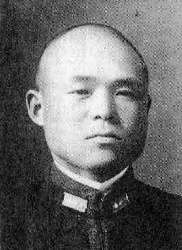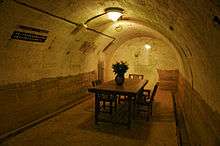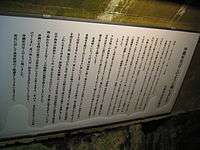Minoru Ōta
| Minoru Ōta | |
|---|---|
 Admiral Minoru Ōta | |
| Native name | 大田 実 |
| Born |
7 April 1891 Nagara, Japan |
| Died |
13 June 1945 (aged 54)[1] Okinawa, Japan |
| Allegiance |
|
| Service/branch |
|
| Years of service | 1909-1945 |
| Rank | Vice Admiral |
| Battles/wars |
|
Minoru Ōta (大田 実 Ōta Minoru, 7 April 1891 – 13 June 1945) was an admiral in the Imperial Japanese Navy during World War II, and the final commander of the Japanese naval forces defending the Oroku Peninsula during the Battle of Okinawa.
Biography
Ōta was a native of Nagara, Chiba. He graduated 64th out of 118 cadets from the 41st class of the Imperial Japanese Navy Academy in 1913. Ōta served his midshipman duty on the cruiser Azuma on its long distance training voyage to Honolulu, San Pedro, San Francisco, Vancouver, Victoria, Tacoma, Seattle, Hakodate and Aomori. After his return to Japan, he was assigned to the battleship Kawachi, and after he was commissioned an ensign, to the battleship Fusō. After promotion to lieutenant in 1916, he returned to naval artillery school, but was forced to take a year off active service from November 1917 to September 1918 due to tuberculosis. On his return to active duty, he completed coursework in torpedo school and advanced courses in naval artillery. After brief tours of duty on the battleships Hiei and Fusō, he returned as an instructor at the Naval Engineering College.[2]

Ōta also had experience with the Japanese Special Naval Landing Forces (SNLF, the Japanese equivalent of the Royal Marines), as he had been assigned command of a battalion of SNLF forces in the 1932 First Shanghai Incident. He was promoted to commander in 1934. In 1936, he was named executive officer of the battleship Yamashiro, and was finally given his first command, that of the oiler Tsurumi in 1937. He was promoted to captain in December the same year.[2]
World War II
In 1938, with the start of the Second Sino-Japanese War, Ōta was assigned to command the Kure 6th SNLF. In 1941, he was assigned to the command of the SNLF under the Japanese China Area Fleet at Wuhan in China. He returned to Japan the following year, and was assigned to command the 2nd Combined Special Naval Landing Force that was earmarked for the seizure of Midway in the event of a Japanese victory over the United States Navy at the Battle of Midway.[3] Although this never came to pass, he was promoted to rear admiral and commanded the 8th Combined Special Naval Landing Force at New Georgia against the American First Raider Battalion.[4] He then served in various administrative capacities until January 1945, when he was reassigned to Okinawa to command the Japanese Navy's forces as part of the Japanese reinforcement effort prior to the anticipated invasion by Allied forces.[5][6]
In Okinawa, Ōta commanded a force with a nominal strength of 10,000 men. However, half were civilian laborers conscripted into service with minimal training, and the remainder were gunners from various naval vessels with little experience in fighting on land. Allied sources are contradictory on his role as commander of the naval elements in Okinawa. Some cite Ōta as able to organize and lead them into an effective force, which fought aggressively against the Allied forces, "withdrawing slowly back to the fortified Oroku Peninsula."[7] But Naval elements, except for outlying islands were headquartered on the Oroku peninsula from the beginning of the battle.[8] Operations Planning Colonel Hiromichi Yahara of the Japanese 32nd Army describes a miscommunication occurring in the order for Ota's Naval elements to withdraw from the Oroku Peninsula to support the army further south.[8] What actually happen is clear: Ōta began preparations on or around 24 May, for the withdrawal of all Naval elements to the south in support of the Army. He destroyed most heavy equipment, stocks of ammunition and even personal weapons. While in mid-march to the south, 32nd Army HQ ordered Ōta back into the Oroku peninsula citing that a mistake had been made in timing (explanations vary). Naval elements returned to their former positions with no heavy weapons and about half the troops had no rifles. The Americans, who had not noticed the initial withdrawal attacked and cut off the peninsula by attacks from the north on land, and one last seaborne landing behind the Navy's positions. Naval elements then committed suicide with whatever weapons possible, with some leading a last charge out of the cave entrances. According to the museum for the underground Naval Headquarters in Okinawa, "many soldiers committed suicide" inside the command bunker, including Ōta.[9]

Ōta committed suicide here.
On June 6, Commanding Officer Ota sent out a telegram to the Navy Vice admiral.[10] On 11 June 1945, the U.S. 6th Marine Division encircled Ōta’s positions, and Ōta sent a farewell telegram to the IJA 32nd Army Headquarters at 16:00 on 12 June. On 13 June, Ōta committed suicide with a handgun. He was posthumously promoted to vice admiral.
Telegraph to the Navy Vice Admiral

Sent at 20:16 on the 6th of June, 1945:
"Regarding the actual situation of Okinawa citizens, the prefectural governor has already lost communication means, although the prefectural governor should report the authority, the 32nd Army Headquarters seems not to have such a margin as well. Although it was not requested from the prefectural governor to the Navy Headquarters, it is impossible to overlook the current situation as it is, so I will inform you of the governor urgently. Since the enemy began to attack on the main island of Okinawa, the Army and the Army devoted themselves to defensive warfare and could hardly look back on the prefecture's people. Regardless, as far as I can tell, the prefectural people applied for defense convocation all the young people and the senior citizens altogether.
The old man, the child, the woman who was left are gone because no one depends on themselves, and all the houses and wealth have been burned all by the bombing of successive enemies, just the arrival of clothes, the disturbance of the military strategy It evacuates to a narrow air defense shelter in a place that does not become, and barely avoids bombardment while still being exposed to the weather while being exposed to the poverty. Young women take the initiative to devote themselves to the military, even to nurses and cooks, as well as those who offer cannonballs and even slaughtering troops.
If the enemy comes, the old child will be killed, and since the woman will be taken away to the enemy's territory and put on the poisonous thing, I will decide to separate and live away my daughter at the military gate There are also parents.
Nurses continue to nurse seriously injured people who can not depend on who the sanitary left behind during the movement of the military. That situation is very serious and I do not believe it was a very temporary feeling. Furthermore, when the strategy of the military changes drastically, they are ordered to relocate to a distant place far away within that night, people without transport means are walking in the rain without complaints . In the end, despite consistent efforts for labor service and goods conservation all the time since the naval forces in and out of Okinawa, just as a Japanese while unconsciously holding the thoughts of the loyalty, (unreadable part) can't finally giving(unreadable part) Okinawa Island together with the outcome of this battle and destiny together, it will become a scorched soy that no one plants will remain .
Telegram addressed to the Navy vice-minister (modern translation) It is said that food is already in full condition only in June. The Okinawa citizens fought in this way. I would like you to give the prefectural people special consideration, this day forward".
References
- Alexander, Joseph H. Storm Landings: Epic Amphibious Battles in the Central Pacific. Naval Institute Press. ISBN 1-55750-032-0.
- Astor, Gerald (1996). Operation Iceberg : The Invasion and Conquest of Okinawa in World War II. Dell. ISBN 0-440-22178-1.
- Feifer, George (2001). The Battle of Okinawa: The Blood and the Bomb. The Lyons Press. ISBN 1-58574-215-5.
- Lacey, Laura Homan (2005). Stay Off The Skyline: The Sixth Marine Division on Okinawa—An Oral History. Potomac Books. ISBN 1-57488-952-4.
- Leckie, Robert (1997). Strong Men Armed: The United States Marines Against Japan. Da Capo Press. ISBN 0-306-80785-8.
- Prange, Gordon W (1983). Miracle at Midway. Penguin. ISBN 0-14-006814-7.
- Wiest, Andrew A (2001). The Pacific War: Campaigns of World War II. Motorbooks International. ISBN 0-7603-1146-3.
External links
- Nishida, Hiroshi. "Imperial Japanese Navy".
Notes
- ↑ Nishida, Hiroshi, Imperial Japanese Navy
- 1 2 http://homepage2.nifty.com/nishidah/e/px41.htm#v007
- ↑ Prange, Miracle at Midway, page 63
- ↑ Alexander. Storm Landings. Page 206
- ↑ Astor. Operation Iceberg. page 462.
- ↑ Weist. The Pacific War:Campaigns of World War II. page 223
- ↑ Feifer, The Battle of Okinawa.
- 1 2 Yahara, Michihiro "The Battle for Okinawa"
- ↑ http://kaigungou.ocvb.or.jp/about.html
- ↑ http://kaigungou.ocvb.or.jp/pdf/eigopan.pdf